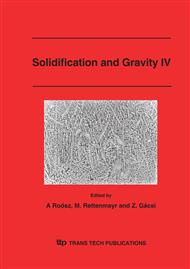[1]
Löschau, W., Juch, K., Reitzenstein, W.: Alloying and dispersion of TiC-base hard particles into tool steel surfaces, European Conf. on Laser Treatment of Materials, ECLAT'92, Göttingen, DGM Verlag, Germany, 1992, pp.281-285.
Google Scholar
[2]
Orlich, J. et al.: ATLAS ZUR WÄRMEBEHANDLUNG VON STÄHLE, Verlag Stahleisen M.B.H., 1972, Düsseldorf.
Google Scholar
[3]
Gasser, E., Kreutz, E.W., Krönert, W., Lohmann, K., Wissenbach, K., Zografou, C.: Dispersion of hard particules in light alloys with CO2 laser radiation (Surface of Aluminium), ECLAT, Göttingen, DGM Verlag, Germania , 1992, pp.651-653.
Google Scholar
[4]
Komvopoulos, K.: Effect of processes parameters on the microstructure, geometry and microhardness of laser-clad coating materials, Proceedings of Second ASM Heat Treatment and Surface Engineering Conference in Europe, 1-3 iunie 1993, Dortmund, Materials Science Forum, Trans. Tech. Publications, vol. 163-165, 1994, pp.417-422.
DOI: 10.4028/www.scientific.net/msf.163-165.417
Google Scholar
[5]
Kovalenko, V.S., Golovko, L.F.: Laser hardening of chrome steels, Industrial Laser Handbook, Editat de D. Belforte, M. Levitte, Springer, 1994, pp.121-122.
DOI: 10.1007/978-1-4612-2882-0_14
Google Scholar
[6]
Vreeling, J.A., Ocelík, V., Pei, Y.T., De Hosson, J. Th.M.: Laser melt injection of SiC particles in Al, Surface Modification Technologies XIV, Edited by T.S. Sudrshan and M. Jeandin, ASM International, Materials Park, Ohio and IOM Communications Ltd., UK, 2001, pp.619-624.
Google Scholar
[7]
Ursache, M., Chircă, D.: ProprietăŃile metalelor, EDP Bucureşti, (1982).
Google Scholar
[8]
Bitay E.: Kerámiaszemcsék diszpergálása lézeres felületötvözésnél, Confer. FMTÜ, 1999, ClujNapoca, pp.169-172.
DOI: 10.36243/fmtu-1999.43
Google Scholar
[9]
Bitay, E.: Tratament superficial cu laser al oŃelurilor cu conŃinut redus de carbon, Teză de doctorat, Universitatea Technică Cluj-Napoca, 2002, p.88. fig. 6. 2.
Google Scholar
[10]
O. Verezub, G. Kaptay, T. Matsushita, K. Mukai: Penetration dynamics of solid particles into liquids High-speed experimental results and modelling, Materials Science Forum Vols 473-474 (2005).
DOI: 10.4028/www.scientific.net/msf.473-474.429
Google Scholar
[11]
Oprea, F., Taloi, D., Roman, R.: Teoria proceselor metalurgice, Ed. Didactică şi Pedagogică, Bucureşti, 1978, p.508.
Google Scholar
[12]
Bitay E.: Karbidporok diszpergálásának vizsgálata acélban, CO2-os lézeres felületötvözésnél, FMTÜ, 1999, Cluj-Napoca, pp.173-176.
DOI: 10.36243/fmtu-1999.44
Google Scholar


